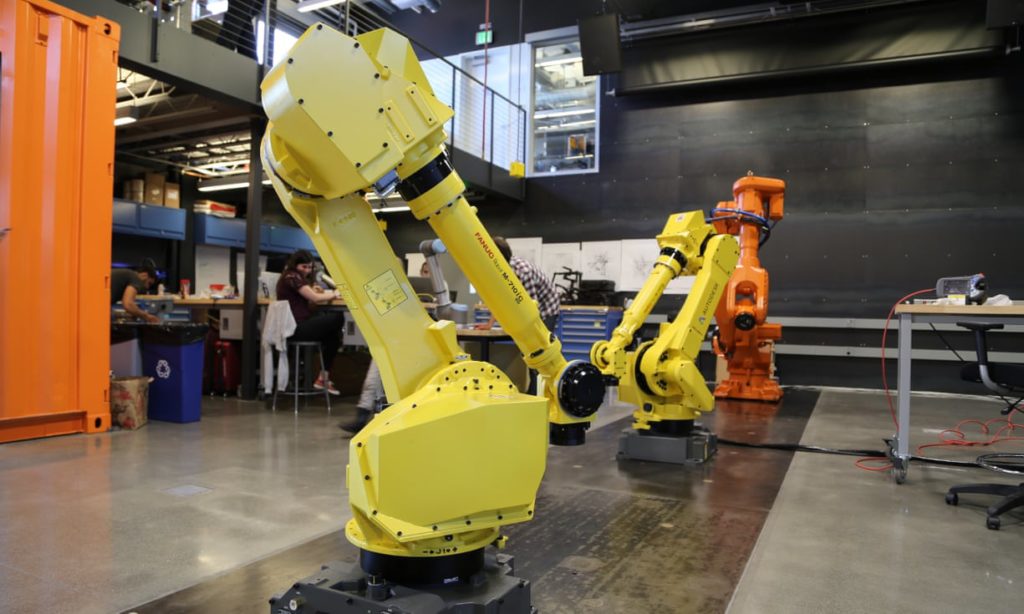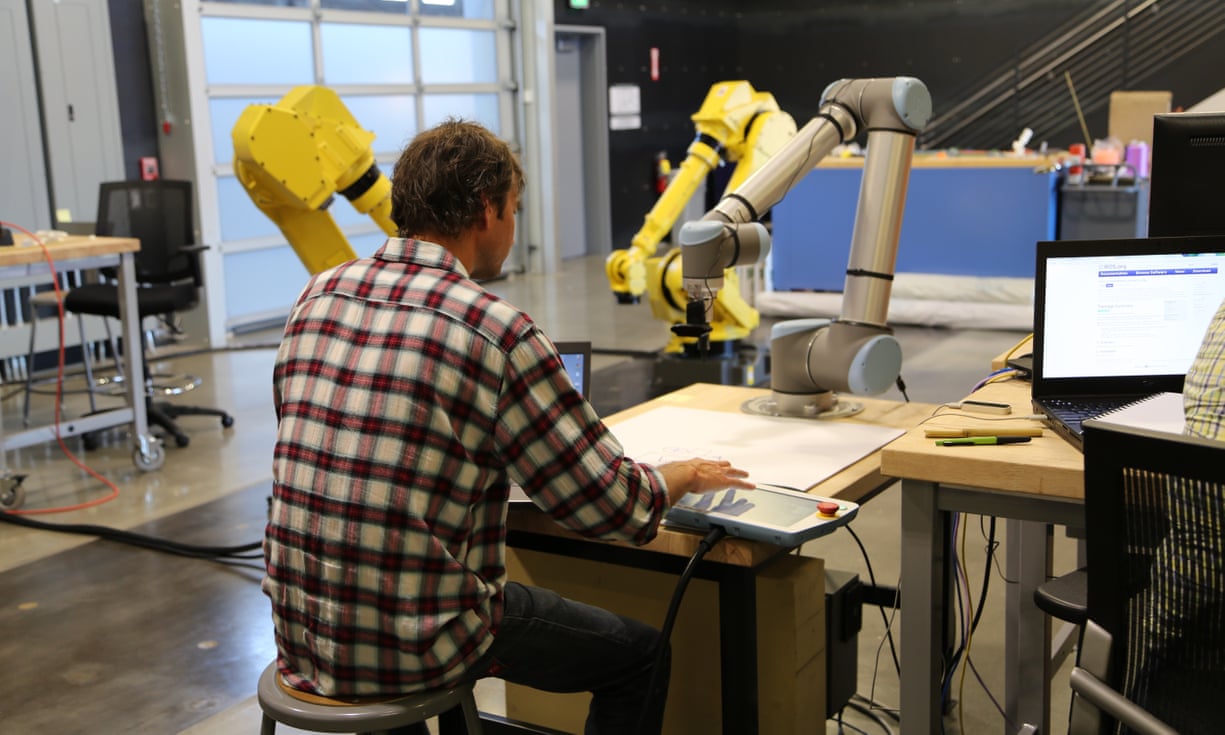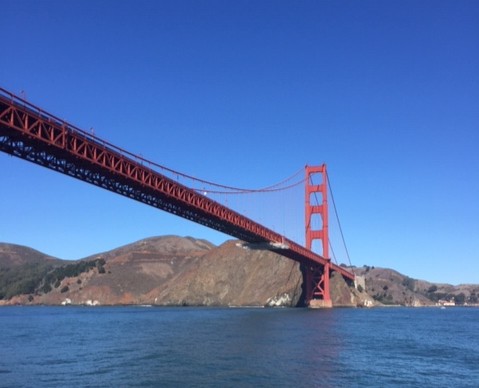Design engineer David Thomasson can see a future where robots make feature films, build cities autonomously and let humans get on with helping each other
If there’s any comfort offered during the current debate around robots, automation and the future of work, it’s that robots can’t do creativity. Machines are great for automated, precise, repetitive work; not so great for creative, expressive work.
Beating beneath the discussion is a steady pulse of fear that once the technology leaps from apprentice to creative independent agent, robots could cause mass unemployment, bring about a dystopian society and steal our very reason for being.
Yet there are some who argue that robots getting creative could actually make the world a better place. Machines will analyse and come up with solutions for environmental problems, such as infrastructure and design, that humans couldn’t possibly conceive, for example.
David Thomasson is the principal research engineer for strategic innovations at Autodesk, the company that creates 3D design software for manufacturing, entertainment, engineering, infrastructure and construction.
Born in Australia and now based in San Francisco, Thomasson is part of Autodesk’s five-person robotics lab team, which is looking at the future of robotics and design. So far he’s worked on robotic film-making and 3D printing a metal bridge, and has just taught a robot how to draw, paint and tune into his facial expressions.
He was in Sydney this month to take part in the RobArch conference, joining architects, designers and artists to discuss robotic collaborations.
In his softly spoken way, he’s excited by what he saw: “These really complicated industrial machines are being used for all sorts of weird, artistic, creative, expressive projects.
“A lot of it is not necessarily practical in terms of building buildings with technology but it’s really artistic expression that’s the most exciting thing.”
In fact, he can foresee a time when man and machine will work together in “a truly creative partnership”. And unlike so many commentators, Thomasson is excited about it. Mostly.
Alexandra Spring: You taught a robot how to draw and paint. How did you do that and what’s next?
David Thomasson: The idea there is to explore this future that we can see coming, where humans and machines are going to be working much more closely. If we are to have any sort of meaningful relationship with robots and machines, we need to be able to communicate with them in a more human-like way [and] be intuitive about it. That involves natural language, gestures, and using facial expressions and body language.
The first steps for us were to do that human-like task of expressing yourself through drawing, so that was to give the robot [one of the senses]. In that case it was vision, with cameras; put cameras in it and then let it respond. Also natural language and understanding so we can talk to it and tell it what we need.
We’ve taken that program out [to market] to be a practical assistant, a practical tool that a tradesman could use. They could take the arm on a trolley to a construction space, and communicate to it where particular work needs to be done, for example cutting holes in gyprock to put light switches in.
That work is fairly repetitive; it benefits from being precise but also benefits from a greater awareness of the space, where that work needs to happen in relation to the original plans. Humans can do that quite well, the translation of information from the designers into plans, the plans being interpreted and you can make sure they can go to the right place accurately. But if we have these machines that are working with us, almost like an apprentice, we can tell them what it is that we want at a high level. Then it can do the work for us and be much more precise and repeatable. That’s where we are at the moment.
We also have a big part of the business which is creative expression, people using the software for story telling, so I can imagine a future where we will use these machines to help us actually create things purely for expression. That’s where it gets back to the drawing, where a person can start a creative endeavour like drawing or sculpting, and the machine can watch what is happening, learn your style and then contribute. [It can] actually provoke you into doing things you may not have thought of before and ends up being a truly creative partnership.
AS: There’s some fear around robots and automation taking jobs, and people are reassuring themselves regarding this by saying robots can’t be creative. You are saying that they can learn creativity. Why is that an exciting thing for you? Doesn’t it make you nervous?
DT: No. I’m an optimist at heart. At the moment all the things that we design, all rely on human creativity. It’s really people who come up with the ideas and then they try to express those ideas in terms of design and get it made. The future lends itself to algorithms and artificial intelligence that have a much greater awareness of our environments than we do. So if we can effectively tell those systems what it is that we want, our goals, preferences, styles, and if they can even learn that without us expressing it, they can make much better judgments, in my opinion, as to what is needed.

So to make a bridge [in the future], for example, you won’t come up with an idea of structure and then adapt that structure to that particular situation. What you say is that the bridge needs to connect to the ground on this side and on that side and it needs to hold a particular weight, now go and give us a few options that satisfy those requirements.
Then [the robot] goes away and thinks for a while and presents thousands of different options. You can sort through that in terms of the look that you prefer or various other parameters that satisfy the need. It comes up with something that no human could possibly have imagined in the first place.
It also tends to be quite organic-looking, it’s getting back to nature’s processes, and nature is much wiser than we are in working out what the world needs. I think we are going to get close to that; with these systems we are going to end up with more creative solutions to our problems. It’s going to end up with more energy-efficient designs, much less waste and more efficient use of human resources. As the machines get creative, it’s going to be much better for us.
AS: What does your job as a designer look like then?
DT: Just to make sure that the robots know that I’m on their side, and not to get rid of me. [Laughs.] I think for a long time there’s going to be room for people who are developing these systems and I see myself as one of those.
Ultimately we’ll get to the situation where we’ll have occupations to work out how to interface meaningfully with machines. It will be much more psychology- and social science-[oriented]. Those will be the skills that people need.
What this is going to result in is that humans spend their time doing what they are good at and that’s relating to other people. These technologies will free us from the mundane tasks that currently a lot of us are involved with, and get back to working out how we get along better.
AS: Do you think new jobs will come out of this?
DT: There will be occupations where people will spend their time working out how to improve the condition of other people. At the moment, there are a lot of people tied up with fairly mundane tasks who have opinions and abilities to make people feel better. Once people are freed up from those tasks, I think the natural tendency will be [to look at] what occupations are required to help us all get along better together. And those occupations are yet to be imagined.
AS: You are working with the Dutch company MX3D to 3D print a fully functional steel bridge over water in Amsterdam. How is that progressing?
DT: Yes, MX3D has come up with the process of the robotic 3D printing with metal. They are driven by an artist called Joris Laarman, who is the creative vision behind the project. We’re contributing through software expertise and research into more intelligent robotic systems.
AS: That has enormous implications for city design and planning. Is there a time when big data will feed into 3D design and these things will come together for infrastructure?
DT: Yes, that’s exactly what I see happening, because this is a pretty solid first step into the world of infrastructure being built autonomously. It’s not a big step to imagine the big data that’s been collected by a city – it knows the flow of people, the traffic, the energy and water requirements, the air quality, all that information will be drawn into a central system. Then artificial intelligence will work out what’s best for the occupants of the city and can make its own decisions about what infrastructure is needed. You can imagine where you can get the robots to go and build another bridge where a bridge is needed, or build another water purification plant, or fix roads. I definitely think that’s where it’s headed.
AS: Where is the human hand in that?
DT: It’s understanding the truly human requirements. Systems like that will understand the logistical requirements and to some degree understand our psychology. I think humans will be involved with helping people cope, to do different occupations that will come about through that. We don’t know what those occupations will be but the city will adapt to our requirements as opposed to the reverse, which is generally what is happening now. Cities are made for pure practical efficiency and people have to fit in with that, but I think this model will reverse.
AS: Thomas Edison reportedly said that genius is 99% perspiration, 1% inspiration. This will take out perspiration entirely, so will humans need to be more inspired and more creative?
DT: I think that’s what will happen because the means of creative expression will be much more widespread. People may have more time and will be more driven to be creative. They won’t be tied in with their day-to-day requirements; they will be free to think at a higher level. I’m not sure how that will play out but I think that’s the way it will go.
AS: You’re Australian but you’re based in San Francisco. Is Australia engaged in this revolution at this point?
DT: I’ve been seeing more and more things pop up. Being part of this conference here, all the six main universities [University of Sydney, Monash University, RMIT, UTS, UNSW, Bond University] here that are involved and all doing world-leading work. And [with] the recent government innovation grants, it seems like a lot of the start-ups are interested in staying here rather than coming over to the States. It definitely does seem like it is becoming a hub.
AS: Have you seen any impressive Australian robotic projects?
DT: One really exciting project is Modbot, who are from Australia but currently in San Francisco. They are designing a low-cost industrial robot arm that will revolutionise the market. At the moment, these machines are quite expensive, and hard for research groups, schools and small businesses to get access to. They are one of the most exciting businesses that I have seen come out of Australia recently.
There’s also construction company Laing O’Rourke that has decided to invest in robotic research and development, which is quite unusual. They are looking into concrete formwork, the concrete that you’ll see next to the expressways, and facades of buildings. Robots carve the forms and then concreters mould it into that. They are quite groundbreaking in the work that they are doing.
AS: What else are you working on that’s really exciting?
DT: We’re investigating machine learning and artificial intelligence in general, so we see the future of robotics is more the physical substantiation of artificial intelligence. It’s really how artificial intelligence is going to interact with the world. That’s a big area of research that involves big data and recording as much information about a situation as possible, and then having the artificial intelligence decide how to manufacture things.
Another area of our research is using robots to perform with people or move a camera around for feature film work. If a person is moving through the space, cameras and screens can follow that person because they have information that is specific to them. [We’re] working on the performative aspects of robotics.
AS: What do you mean by performative aspects?
DT: The machines can move like people, can encourage interaction and participate in physical creation, be it dance or sculpture or drawing. These machines are taught to move with us in lifelike ways. There’s a lot of research going into how to do that.
AS: Could we have an Oscar category for best performance by a robot?
DT: I wouldn’t be surprised, yes, and ultimately it will get into human-like robots. Last night there was a performance [Huang Yi & Kuka] in Sydney of a dancer on stage with an industrial robot, choreographed for an hour of man-machine communicating with each other. That was quite heavily pre-programmed, but more and more it’s going to get into the robot as an active intelligent agent, responding in real time. I have no doubt that’s going to create new interest for people to see what this human-machine interaction can produce.
The amazing thing is how quickly it’s happening. There’s a tendency to think this is all pie-in-the-sky stuff but what was amazing for me was to see Google’s Alpha-Go program beat one of the world champs in Go. Two years ago, all the AI researchers in the world were predicting that would be 10 years away. Then sure enough, two years later, that’s happened. This exponential progress is happening at the moment and it’s really hard for us to keep up with the potential impact that it’s going to have.
AS: And you are still optimistic?
DT: Yes, I think it’s going to contribute to solving a lot of the problems we have at the moment. Longer term is going to get interesting once artificial intelligence gets way beyond our capability, then things are going to get messy potentially. That’s a huge area of research – the study of morals and ethics and how to see that happens safely. That’s much more of a grey area, I’m not sure about the optimism there.
Published in Guardian Australia on 29 March 2016 as Can machines come up with more creative solutions to our problems than we can?



